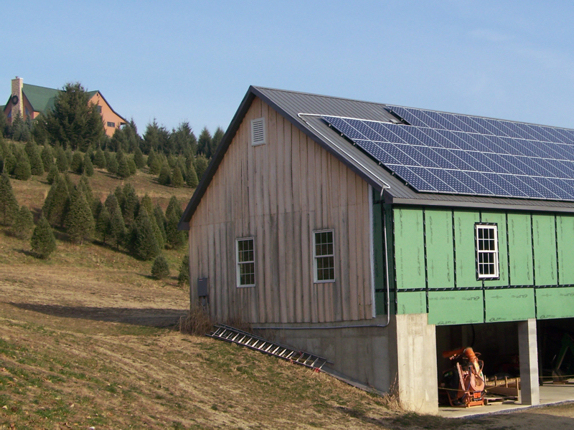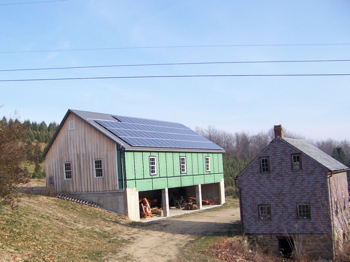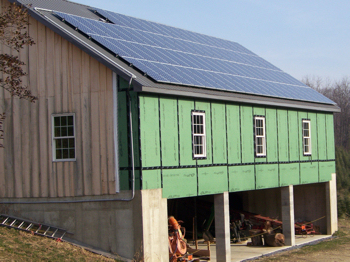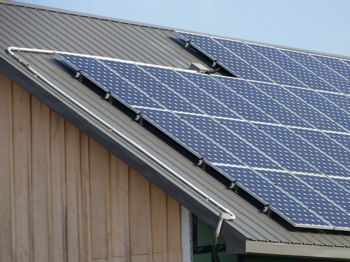Pennsylvania Farmer Turns To Solar Power For Portion Of Energy Needs

By Scott Kriner, Green Metal Consulting
The idea of starting a blueberry farming business does not usually conjure up images of photovoltaic arrays. But for an entrepreneur in Slatington, PA, one thing led to the other.
Over a period of 42 years, Lou and Ann Bernard raised a family in that area of Pennsylvania and Lou continues to live in the 1850s farmhouse. The surrounding 30 acres of land, consisting of rolling hills and valleys, are covered
with Christmas trees of all size. In fact the Green Valley Farm has been in the business of selling Christmas trees for over 30 years.
That landscape changed after Lou attended a seminar on blueberry farming. He became very interested in the idea and talked to his son, Jon, about it. They were immediately excited by the prospect of supplementing the tree farm
with a large patch of blueberries, blackberries and raspberries. The first question that came to mind was how to irrigate the patch. The quick answer was to use water from the pond on the property. But how would they pump the water
from the pond to the sprayers located in the patch? The solution there was to use a solar powered pump located at the pond. But would the solar powered pump be adequate?
 |
The Bernards' new barn houses equipment needed to tend to the land, as well as a small saw mill.The orientation of the new barn was critical to maximizing the energy generation by the polycrystalline PV units on the south-facing roof
surface. Click images to enlarge.
|
 |
The PV system is a 14.4 kW output and has produced 12 kW on a sunny day. It was installed upon a metal roof finished with a Valspar SMP
Weather X paint in a Charcoal Gray color. Click images to enlarge.
|
 |
| |
This led to the idea of building a small shed near the pond, so that a larger array of photovoltaic modules could be installed to generate the electricity to power a larger pump. But Lou and Jon didn’t stop there. They both had dreamed
of building a large barn for containing farm equipment and a saw mill, and of using the roof area as a platform for a much larger photovoltaic array. That dream came true for the Bernards in the summer of 2009.
An electrical engineer by trade, Lou left very little of the construction project and planning for the PV system to chance. Many calculations were made to determine how much energy was needed for the cooling and heating of the farmhouse,
and for the equipment in the new barn, the existing barns and the irrigation pump. The farmhouse uses all electric for air conditioned cooling and for heating. Given the vintage of the house, there is very little insulation in place
and air infiltration is prevalent.
Blue Valley Builders Inc. was selected as the contractor for the new barn project. The orientation of the new barn was critical to maximizing the energy generation by the polycrystalline PV units on the south-facing roof surface. Likewise,
the slope of the south-facing roof was important. Lou had researched this as well and specified that the angle be 34 degrees. The next choice that was necessary was the materials for the envelope of the barn. The wall cladding was to
be made from planks cut in the sawmill on site using downed trees from the property. But the roof was to be metal. Lou wanted a roof that was durable and would outlast the PV system. He did not want to use slate because of the high
cost, and he was not interested in asphalt shingle because of the relatively short service life in that region of the country.
A prepainted 26-gauge ACH26 ABM metal roof profile, supplied by A B Martin of Lancaster, PA, was ultimately chosen. The paint system was Valspar’s SMP
Weather X in a Charcoal Gray color.
Ground was broken in March 2010. Six weeks later the barn project was finished, except for a few wall planks that needed to be prepared. Astrum Solar provided 79 photovoltaic modules for the roof, and installed all inverters, disconnects, reversible
meters and a digital dashboard to monitor energy production and consumption. Lou agreed to let Astrum purchase the Renewable Energy Credits from the installation for the first 15 years, and use that against the upfront cost of installation.
He also took advantage of the federal tax credit of 30% and also the $2.25/watt rebate available through the Pennsylvania State Sunshine program.
The PV system is a 14.4 kW output and has produced 12 kW on a sunny day. Comparing the electricity usage in 2010 with the PV installed, against the same period in 2009, Lou is finding a 7000 kWh advantage. From when the PV system was put
in place and through the end of November 2010, enough electricity has been produced by solar power to run 27 light bulbs 24 hours a day for an entire year. Lou expects to see his electric bill cut in half compared to last year. He calculates
his estimated payback for the PV array to be 6 years.
The first crop of berries will not be available before 2013. But for now, the Bernards are confident that they made a wise choice in using metal roofing as the platform for their PV array. The irrigation system is in place and ready to use, the
farmhouse is cool in the summer and warm in the winter, the meter is running much slower than in the past, and the bills are much lower. The future is brighter for Green Valley Farms thanks to the solar power and the vision of the Bernards.
 The author, Scott Kriner, is the president and founder of Green Metal Consulting Inc. He is a LEED Accredited Professional who began his career in the metal construction industry in 1981. His company is a member of the U.S. Green Building Council, the California Association of Building Energy Consultants and the Residential Energy Services Network (RESNET). Scott can be reached by email at skriner1@verizon.net or by phone at (610) 966-2430. You can also visit him on the web at www.greenmetalconsulting.com.
The author, Scott Kriner, is the president and founder of Green Metal Consulting Inc. He is a LEED Accredited Professional who began his career in the metal construction industry in 1981. His company is a member of the U.S. Green Building Council, the California Association of Building Energy Consultants and the Residential Energy Services Network (RESNET). Scott can be reached by email at skriner1@verizon.net or by phone at (610) 966-2430. You can also visit him on the web at www.greenmetalconsulting.com.